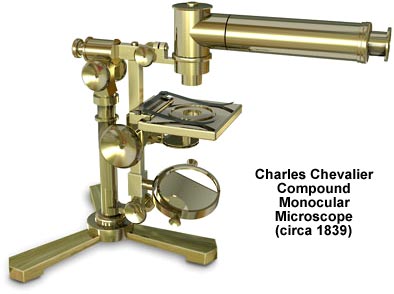Charles Chevalier Compound Monocular Microscope
Built around 1839, this microscope is a smaller version of Chevalier's universal microscope. The original model, from which our 3-D Studio Max drawing is derived, resides in the Billings Microscope Collection at the National Museum of Health and Medicine at Walter Reed Army Hospital in Washington, D. C.

The tripod base supports a cylindrical pillar that has a compass joint at the top, to which a short horizontal arm is attached. Both the horizontal microscope body tube and a vertical square limb are attached to the arm. On the limb is a rectangular stage which is moved up and down with a rack and pinion mechanism to focus the microscope. Clips on the stage are used to secure the specimen. Beneath the stage is a double mirror, which is flat on one side and concave on the other. The body tube slides on the prism box and has a single compound ocular with a breechlock fitting. The objective is threaded and fits into the bottom of the prism box.
BACK TO NINETEENTH CENTURY MICROSCOPES
